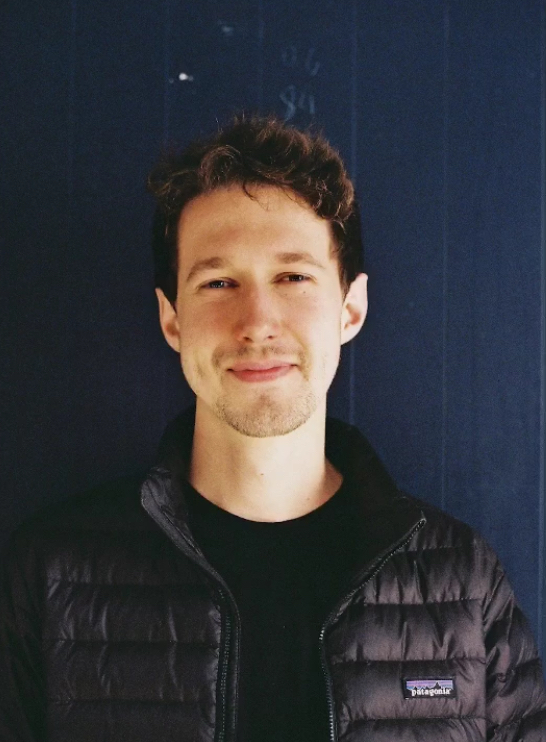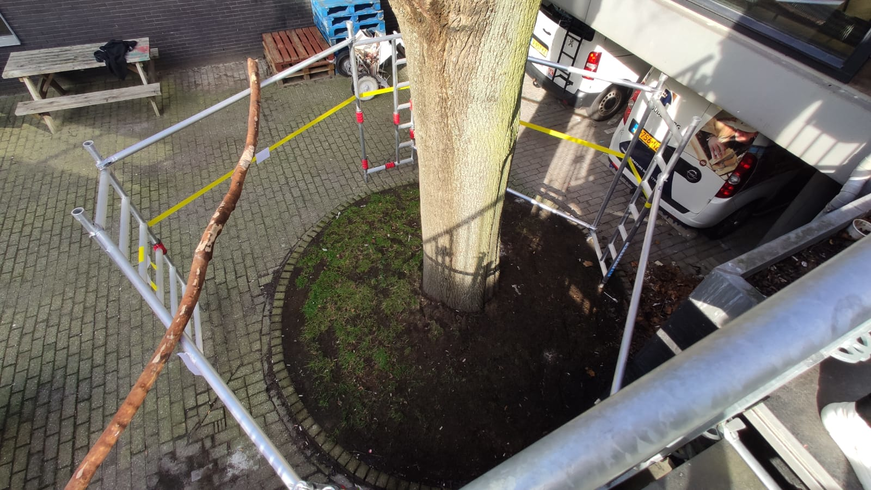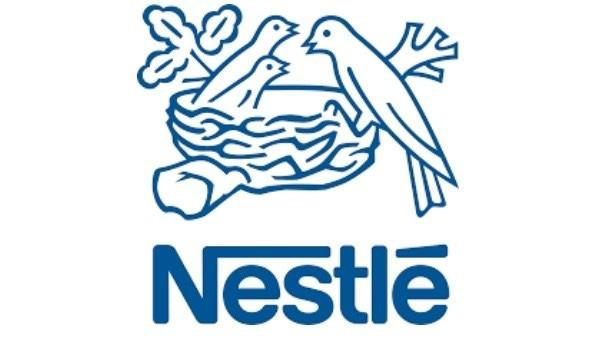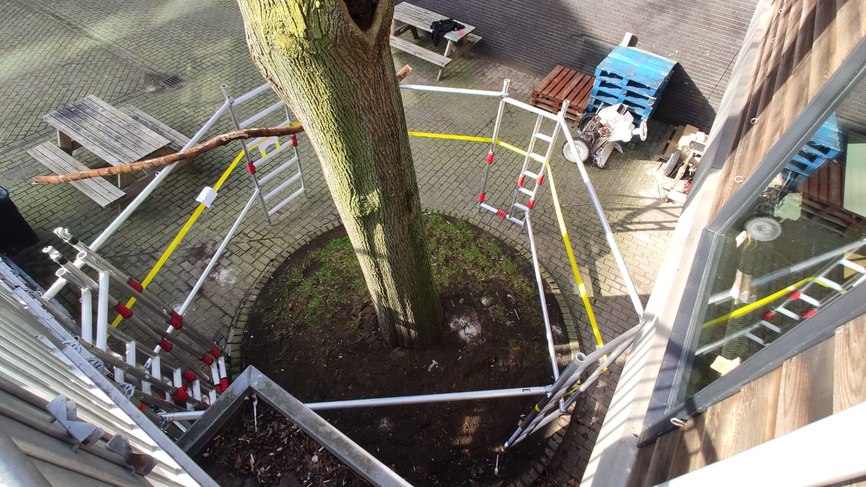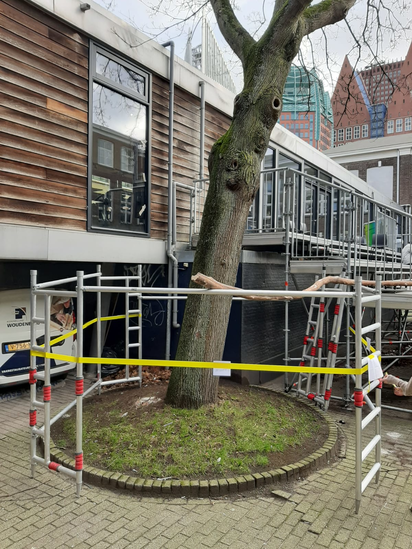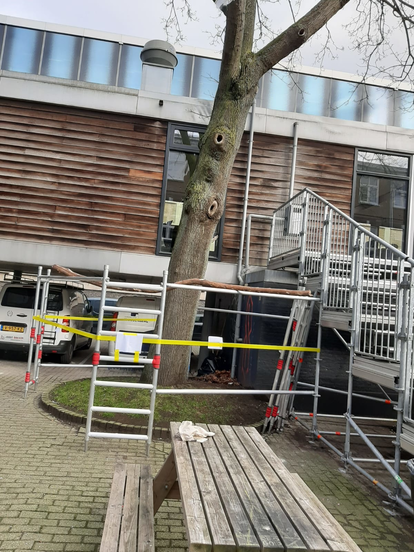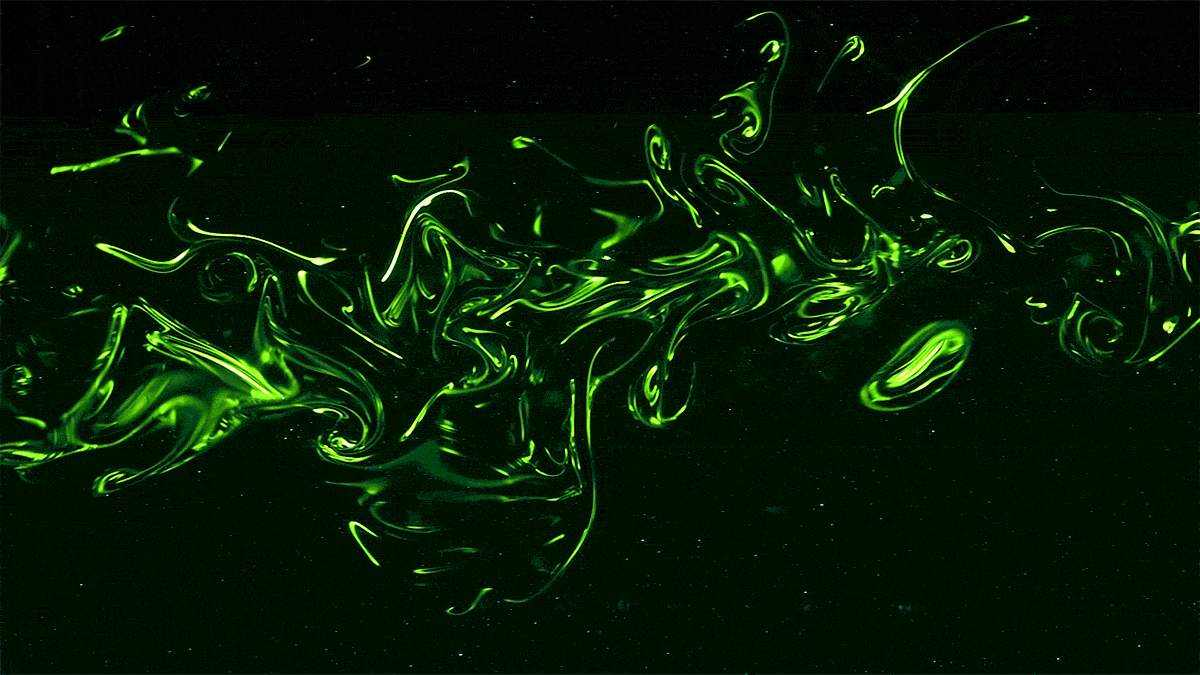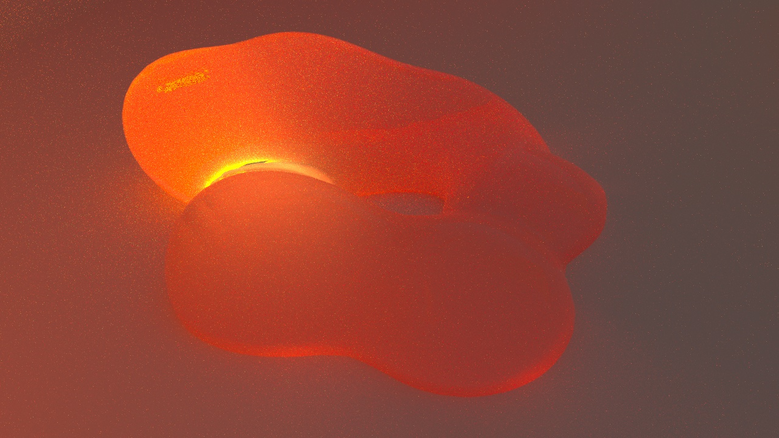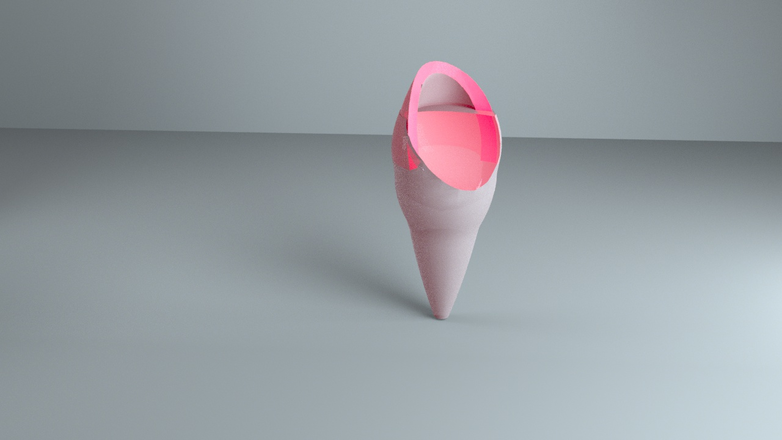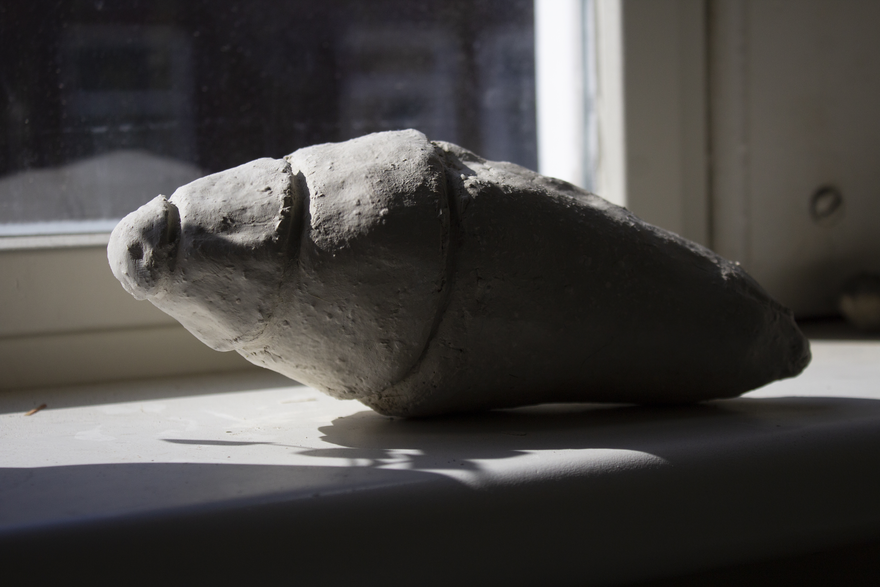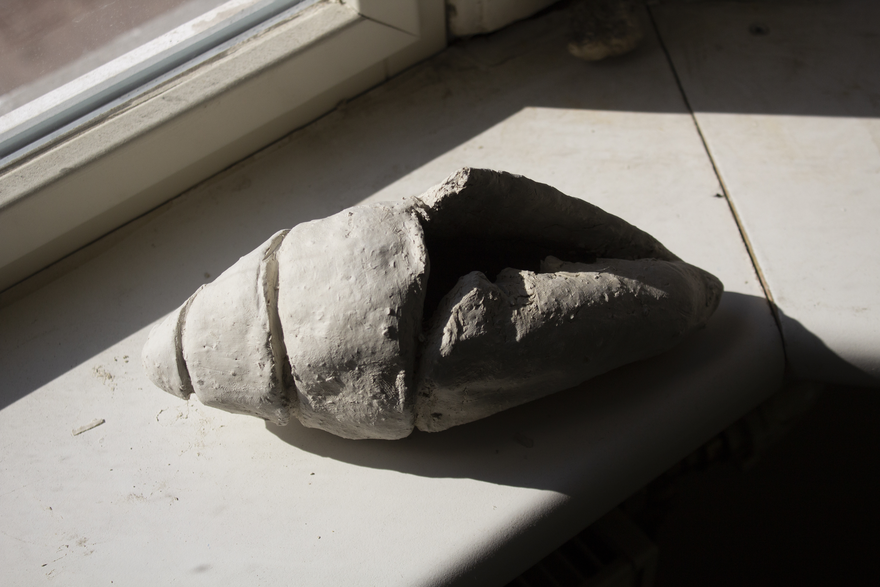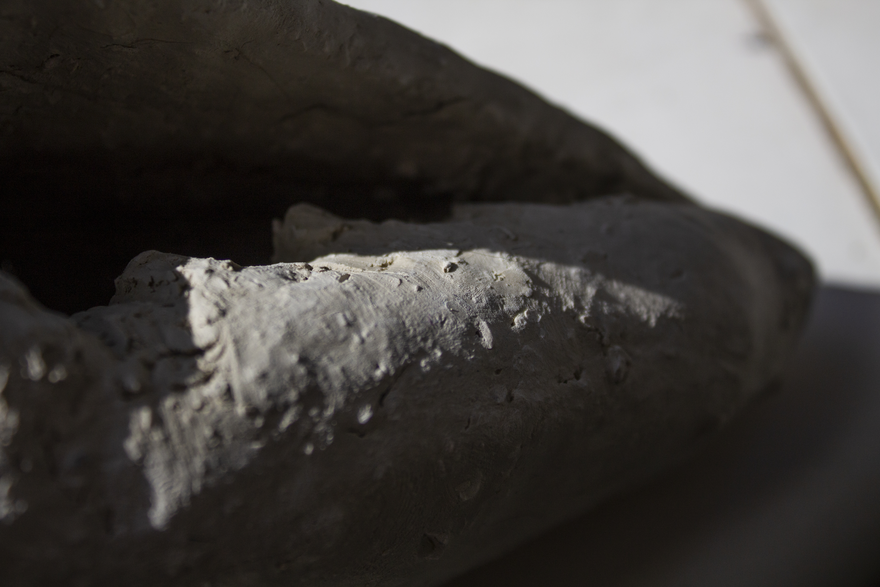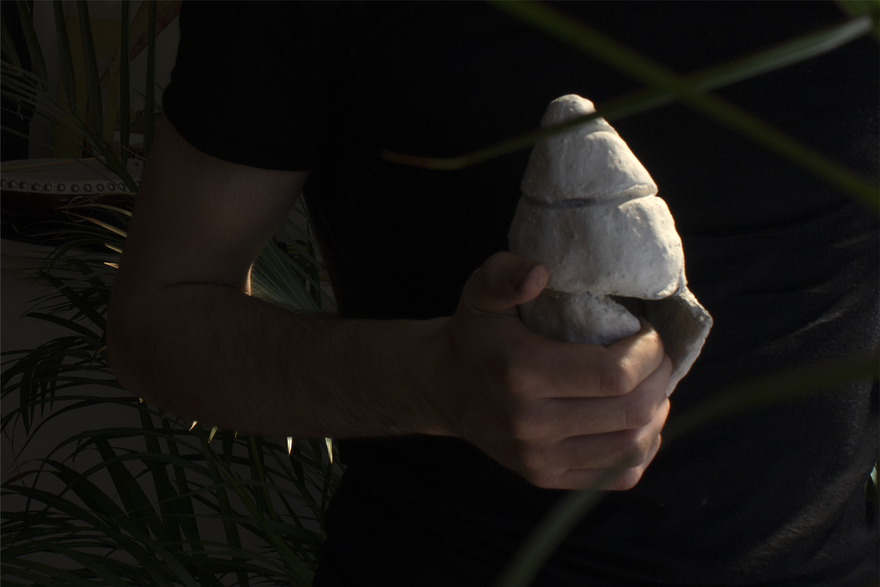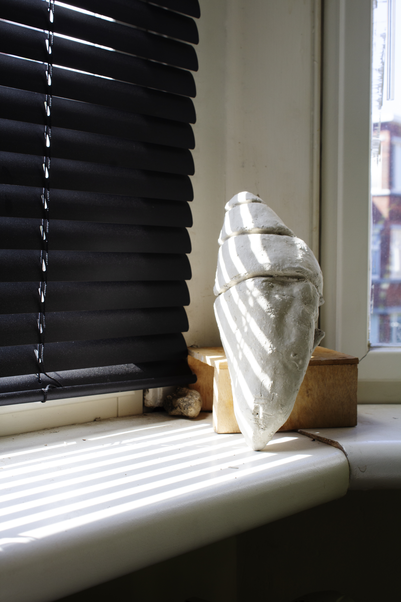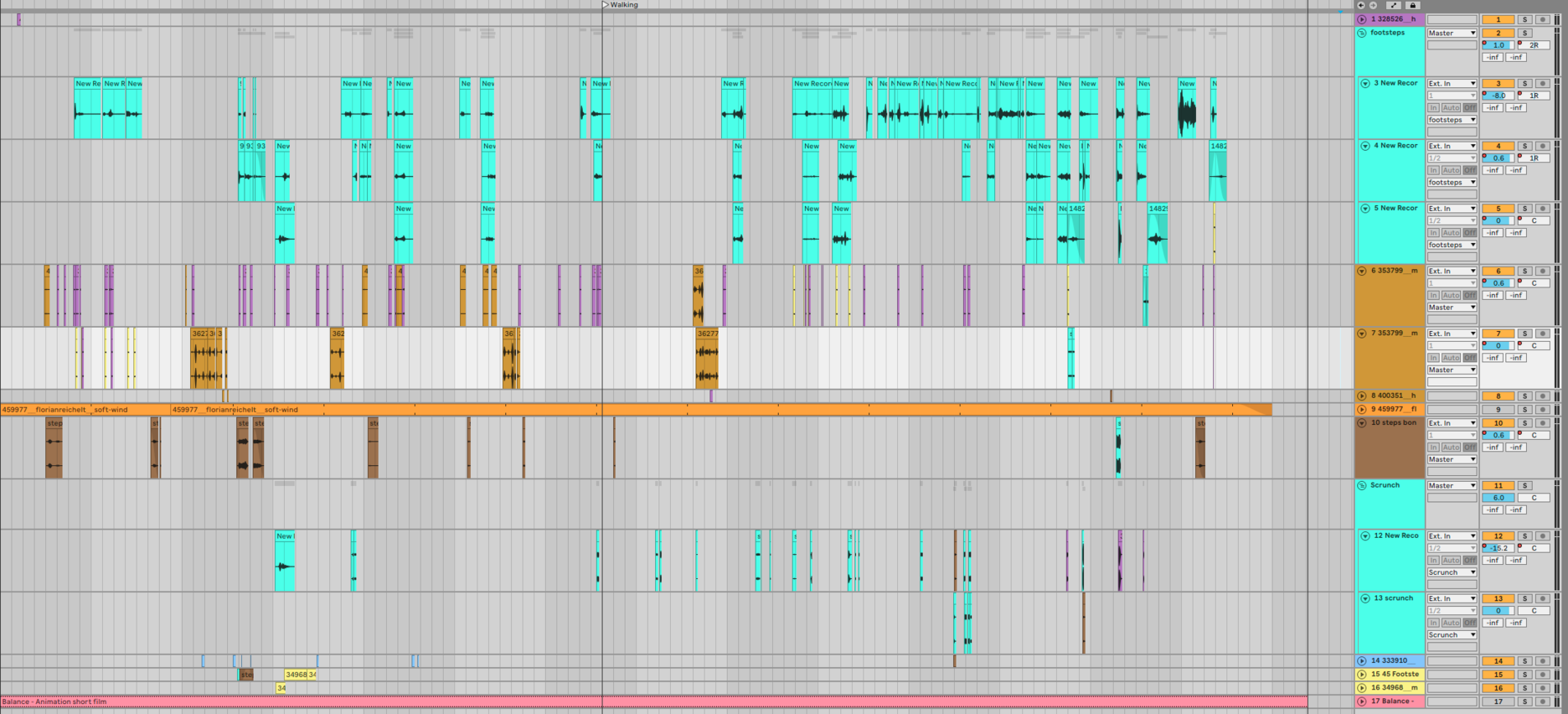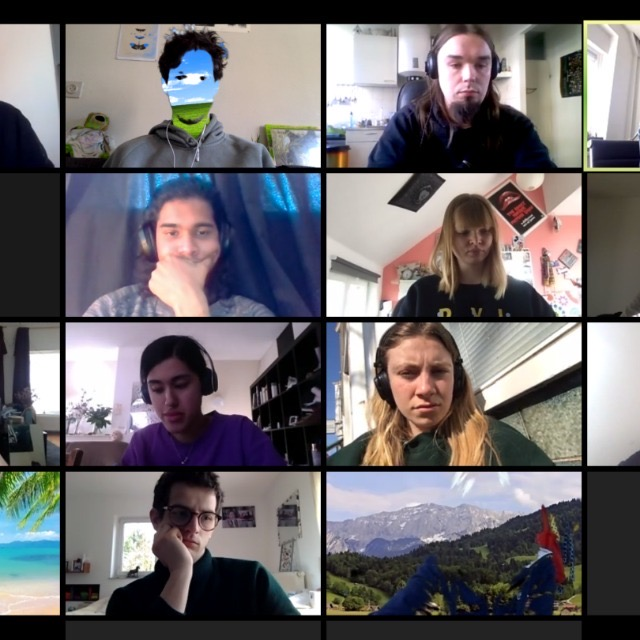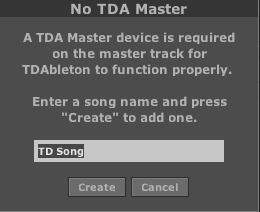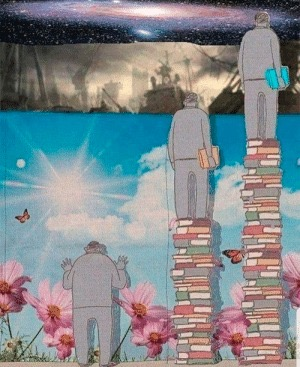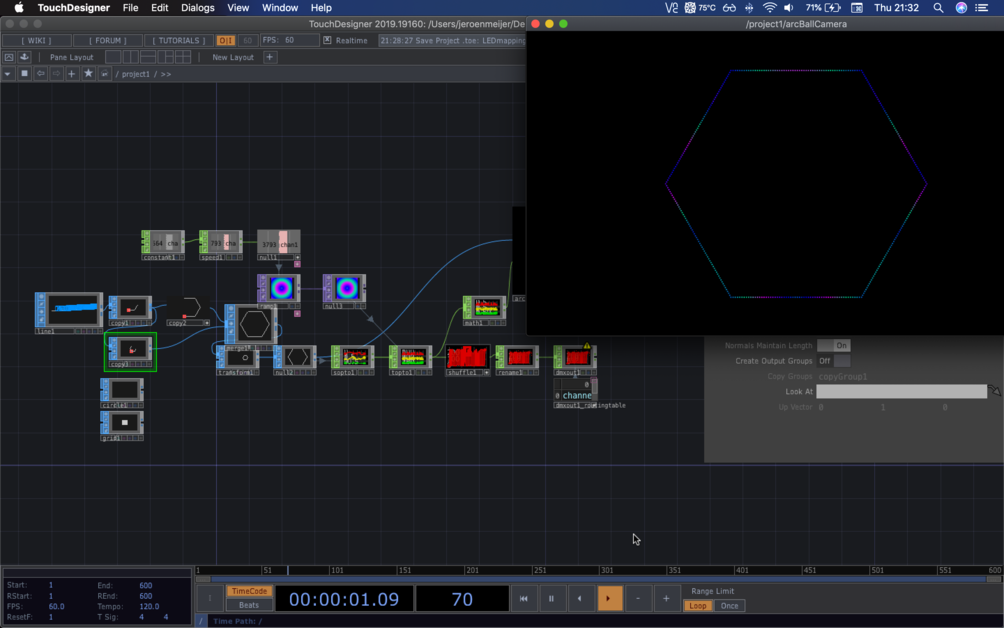To navigate this space you may scroll left, right, up or down. Or you can use the navigation button in the top left menu.
This collaboration with the deparment of Interior Architecture and Furniture Design would prove to teach me the opposite of what I had inititally expected.
At the start of the course we were given the assignment to take a large size corporation and it's logo - which we would reinterpreate in a humorous but informative way - with the goal of exposing that which is hidden behind the facade of business marketing and PR. For our medium we were asked to build a large scale installation of this logo which would be located in the courtyard. So I was looking forward toward learning large scale building skills from the IAFD students.
After discussing several options our group settled on Nestle. We decided to build an actual "Nest" around the tree standing in the school courtyard next to the platform. This nest would exemplify Nestle's "innocent" identity by showing an all natural exterior, but would surprise the visitors as they entered inside. The inside would be covered in the trash wall of candy wrappers and other processed foods produced by Nestle. There would be automated birds pecking at you, ordering you to buy Nestle Products. And their would be screens informing you about Nestle's dealings with babypowder in thrid world countries killing thousands of infants.
My role at this stage was coming up with design ideas, researching the Nestle Logo and understanding how we were technically going to build a Nest using scaffolding materials from IAFD.
Until Corona settled in.
After the Corona virus lockdown we went back to the drawing board to reflect on how we were going to communicate our story virtually. We brainstormed on animations and 3D renders but ultimatlely decided to use the Unity Game Engine as our medium.
At this time I played a role in managing the task division within the group, because all IMD students had previously gained experience making a game. It had taught us the importance of assigning roles to cooperate effectively.
So we divided the team in tasks of 3D Modeller, Sound Designer, Game Designer, Narrative & Story Designer and Interaction Designer. I naturally slid into the role of "Sound Designer" because I had already started using sound in my sketches to explain the story we wanted to tell. And I also wanted to become more familiar with using the Ableton Live software.
In another sense, together with Chloe and Melisa, my role was to keep on managing the task divisions in the group, making sure everyone knew what to do.
Slowly as the game evolved I found, manipulated and provided the sounds heard in the game. And next to this I helped working on the video transitions seen in the game.
The process worked from the background to the foreground. It started with discussing the story with Chloe and Melisa to understand what kind of game we were creating. Then for each scene we had to decide on the atmosphere we wanted to portray. After that was done I would start researching and manipulating sounds that fit our narrative. When I progressed I communicated the new sounds to the group to get feedback. And consequently I refined the sounds and then uploaded them to the drive so Melisa could place them in the game.
After filling in the background we would move into details like: How do we want the baby to sound? What kind of voice do we want for the CEO? And I would repeat the above process.
Welcome to the Collectives of the second semester of my second year at IMD.
Obvious as it may be I feel the need to underline the tumultuous start of this year.
Following an abnormally large wave of global protest in 2019 we've seen long standing ecological, economic and now racial instabilities show their indisputably unhinged nature. Most of us have become aware that many facets of global society appear unsustainable. But it seems only recently that people have started to act on this understanding.
And so to give context to these collectives I must mention that this semester at KABK (and at home) has been shaken by the significant events of the past months. Questions I have have been asking myself are: Is what I'm doing relevant in the face of global uncertainty? and Where do I place an emphasis with my work to contribute to the possibility of societal change? Among others these questions were floating in my mind from the beginning of the lockdown till the end of this semester.
In this exhibition you will see these questions might still remain unanswered. But upon inspecting the work closer it is possible to encounter hints of their exploration.
Going forward into the third year I intend to have these questions shape my undertakings more than I have before.
// Soshel
/* Sketch to control a 28BYJ-48 stepper motor with ULN2003 driver board and
a NeoPixel LEDring with a TouchSensor and Arduino UNO.*/
// LedRing
// Include the Adafrui_Neopixel.h library:
#include <Adafruit_NeoPixel.h>
// Define the LEDring pin:
#define PIN 13
// Define NeoPixels:
// Parameter 1 = number of pixels in strip
// Parameter 2 = Arduino pin number (most are valid)
// Parameter 3 = pixel type flags, add together as needed:
// NEO_KHZ800 800 KHz bitstream (most NeoPixel products w/WS2812 LEDs)
// NEO_KHZ400 400 KHz (classic 'v1' (not v2) FLORA pixels, WS2811 drivers)
// NEO_GRB Pixels are wired for GRB bitstream (most NeoPixel products)
// NEO_RGB Pixels are wired for RGB bitstream (v1 FLORA pixels, not v2)
Adafruit_NeoPixel strip = Adafruit_NeoPixel(12, PIN, NEO_GRB + NEO_KHZ800);
// IMPORTANT: To reduce NeoPixel burnout risk, add 1000 uF capacitor across
// pixel power leads, add 300 - 500 Ohm resistor on first pixel's data input
// and minimize distance between Arduino and first pixel. Avoid connecting
// on a live circuit... if you must, connect GND first.
// StepperMotor
// Include the Arduino Stepper.h library:
#include <Stepper.h>
// Define number of steps per rotation:
const int stepsPerRevolution = 2048;
// Wiring:
// Pin 8 to IN1 on the ULN2003 driver
// Pin 9 to IN2 on the ULN2003 driver
// Pin 10 to IN3 on the ULN2003 driver
// Pin 11 to IN4 on the ULN2003 driver
// Create stepper object called 'myStepper', note the pin order:
Stepper myStepper = Stepper(stepsPerRevolution, 8, 10, 9, 11);
// TouchSensor
// Define the TouchSensor pin:
#define TouchPin 7
// Integers
// Declare integer "Index" to store values:
int Index = 0;
// Declare integers "i" and "j":
int i, j;
void setup() {
Serial.begin(9600); // begin Serial communication at a baud rate of 9600
strip.begin(); // open communication with the LED strip
strip.show(); // initialize all pixels to "off"
myStepper.setSpeed(5); // set the stepper speed to 5 rpm
}
void loop() {
int TouchValue = digitalRead(TouchPin);
if (Index == 0) { // if "Index" is 0
strip.show(); // then initialize all pixels to "off"
}
if (TouchValue == HIGH) { // if the TouchSensor is being touched
if (Index == 0) { // and if "Index" is 0
Serial.println("brightentighten"); // then print "brightentighten" on the Serial Monitor
brightentighten(); // brighten the LedRing, tighten the StepperMotor
Index = 1; // and change "Index" to 1
}
}
if (Index == 1) { // if "Index" is 1
strip.Color(255,255,255); // set all pixels to "on"
strip.show(); // show
}
if (TouchValue == LOW) { // if the TouchSensor is not being touched
if (Index == 1) { // and if "Index" is 1
Serial.println("darkenloosen"); // then print "darkenloosen" on the Serial Monitor
darkenloosen(); // darken the LedRing, loosen the StepperMotor
strip.show(); // and initialize all pixels to "off"
Index = 0; // change "Index" back to 0
}
}
}
// Create a function to Brighten LedRing and Tighten StepperMotor
void brightentighten() {
for (j = 0; j <= 230; j+=10) { // for as long as "j" is below "230" increment "10" and execute the following
for (i = 0; i <=strip.numPixels(); i++) { // and for as long as "i" is below "numPixels" increment "1" and execute the following
strip.setPixelColor(i,j,j,j); // set pixel color for pixel "i" and rgb value "j"
myStepper.step(1); // move StepperMotor "1" step
}
strip.show(); // initialize all pixels to "off"
delay(1); // delay "1" millisecond to avoid jitter
Serial.println(j); // print value of "j"
}
Index = 1; // change "Index" to 1
}
// Create a function Darken LedRing and Loosen Steppermotor
void darkenloosen() {
for (j = 230; j >= 0; j-=10) { // for as long as "j" is above "0" decrement "10" and execute the following
for (i = 0; i <=strip.numPixels(); i++) { // and for as long as "i" is below "numPixels" increment "1" and execute the following
strip.setPixelColor(i,j,j,j); // set pixel color for pixel "i" and rgb value "j"
myStepper.step(-1); // move StepperMotor "-1" step
}
strip.show(); // initialize all pixels to "off"
delay(1); // delay "1" millisecond to avoid jitter
Serial.println(j); // print value of "j"
}
Index = 0; // change "Index" to 0
strip.show();
}
This course started off with an intriguing visit to the Geriatric Ward of OLVG West Hospital in Amsterdam.
With the help of the managing doctor of the department there we were educated about dementia and the mental state of the Geriatric patients who visited the hospital. The doctor taught us about the forgetful condition of their patients and why it caused them great suffering. Patients would forget where they were, forget even who they were and - for relatives the most painful - forget who others were.
The doctor explained to us the fascinating neurological connection smell has to memory, which has everything to do with the olfactory bulb in the brain being closely located to the part of our brain that deals with remembering.
So off home we set thinking of ways to help these patients access their remote memories.
Our process gained ground towards considering using smell to get the patients to move about. Particularly smells which are familiar but you wouldn't easily come by in a hospital. Like the smell of the sea, or the smell of a flower or a forest. Our idea was to make wifi enabled smell modules which would hang in different locations within the Geriatric Ward. These modules would each in turn emit their smell a minute after the other. So the patients would be motivated to seek where the next smell would be coming from.
After the Corona Lockdown our ship was forced to change course. With the help of Pawel and Andrew we reoriented towards design for times of lockdown. Along with this change I was regrouped tothether with Simbu, Marco and Arbaz.
Inititally our group set sail on designing for neighbourhood interaction. But we soon figured out we were naively navigating our new course without doing the proper research. And before we knew it, we were floating in a a thick mist.
Were people experiencing these problems we had conceived? Is it true that neighbours want more interactions? What are the actual challenges our we face in a lockdown?
Asking these questions guided us home to the trustworthy design approach of research. And thus we created a survey asking similar questions ultimately giving us the data we needed to renavigate.
As our data and research was now clear, so was our new course. It was "Loneliness" which proved to be the most influential challenge experienced in our survey group, and more specifically the suddenly discernable shortcomings of digital communications technology. So we set out to ammend the current state of two dimensional interactions existing on our desktops today and design for people to transcend this flat and virtual environment.
In this assignment we were asked to redo the sound design of this classic Italian Animation called La Linea. We were motivated to completely rethink te surrounding area and the character of the sound design.
In this assignment we were asked to create a song that was conspiciously structured like almost all pop music. Containg a verse (A), a Chorus (B), a Verse, a Chorus, a Bridge (C) and another Chorus.
For Sound Design there was little to no change due to the Corona Crisis. Although our meetings with Remus shifted from meat space to the desktop space, it did not interupt our curriculum.
This consistency proved to be a commemorating moment of school structure every friday. We would meet with Remus in the morning to disccus our work and his feedback, and then we would all have class collectively in the afternoon. During these afternoons Remus taught us about using Ableton Live and unearthed the ethical and moral consequences of the use of Sound Design. At this moment I started to understand both the manipulative misdirection and informative guidance enabled by sound.
During the course I had also followed a two week workshop in collaboration with the Conservatory called "Resonance and it's Acoustic Bodies". This workshop turned out to be a great introduction the process of listening, understanding acoustics and learning about the physical properties of sound.
Around this section of the Collectives exbition you will find a flurry of different sonic "experiments", like sound design of animations, National Geographic clips and other kinds of short musical compositions.
Under the header "beats" you will find a few beats that I have created in my spare time.
Here we were asked to take this Joe Exotic clip, and reemphasize the placement of tension using Sound Design
In this playful piece of work Remus asked to completely reinterprate a National Geographic video about global warming by redoing the sound design.
During our course with Sara and Benthe we were given an entire semester to develop a work. I was eager to use this time to continue a project I had started in the first year, but for which I did not yet posess the technical skills to realize what I had in mind. My resolution was to learn how to control light and sound using TouchDesigner (wich I had started to pick up in the previous semster) combined with Ableton Live (for which we now had a Sound Design class).
My initial idea was to tell the story of depression through the metaphor of the tunnel. But as I reflected on the experience I wanted to portray it became more complete. Showing a young adults journey through life, going from naive childhood to the cognitive dissonance an depression of a teenager. Where finally this cold and colourless depression would be transcended by looking within.
Learning how to use TDAbleton (the software to connect TouchDesigner and Ableton) was a lot of fun because it gave me the abililty to cue and control the lights based on midi notes, equalizer and volume controls.This allowed for convenient synchronisation of sound and light.
On the right you can see a first test using TDAbleton.
And below that you can see inside the softwares and how they are connected by a TD component within Ableton.
Passage is a culmination of past and present experience. It draws on the after effects of a depression, and is developed using newly acquired tecnhiques of sound and light. It portrays a message about depression which in modern times has become hard to communicate.
It's important to mention that in our society talking about depression is hard for a variety of reasons: words can not fully express the scope of the actual experience, not to mention that the subject has become stigmatized, but most of all those who have not experienced this the state of "colorlessness" find it difficult to relate.
With this sonic and luminous installation I invite people into a passage from birth to adulthood. Experiencing the stages, from naïve to knowing, from ignorance to wisdom and from devastation to transcendance.
Passing through this journey I aim to show people the universal experience of the cognitive dissonance experienced when our beliefs turn out to be untrue. When our old worldview is replaced by the next. And when we have to let a part of ourselves go, resulting in an allegorical death.
This IST by Channa Boon gave us a completely open space to experiment. Anything concerning the field of sound was allowed. My interest had layed in the vibration of matter and how we see these patterns of vibration all around nature. Next to this I used the space to experiment with Sine Waves and Binaural Sounds. Introducing some of that research into "Passage". The project for interactive narrative.
Binaural sounds have the unique characteristic of a slight difference in the tone frequency hitting each ear. This has been shown do induce us into certain meditative states. The difference in frequencies has also been linked to neurological waves discoverd in the brain. Among these are Beta (20Hz, left), Gamma (60Hz, middle) and Theta (6Hz, right) waves.
During this course I did a lot of listening. Searching sounds that could fit the composition I was making for "Passage". Here you can find a few samples I found which are used in the soundtrack.
Passage is a culmination of past and present experience. It draws on the after effects of a depression, and is developed using newly acquired tecnhiques of sound and light. It portrays a message about depression which in modern times has become hard to communicate.
It's important to mention that in our society talking about depression is hard for a variety of reasons: words can not fully express the scope of the actual experience, not to mention that the subject has become stigmatized, but most of all those who have not experienced this the state of "colorlessness" find it difficult to relate.
With this sonic and luminous installation I invite people into a passage from birth to adulthood. Experiencing the stages, from naïve to knowing, from ignorance to wisdom and from devastation to transcendance.
Passing through this journey I aim to show people the universal experience of the cognitive dissonance experienced when our beliefs turn out to be untrue. When our old worldview is replaced by the next. And when we have to let a part of ourselves go, resulting in an allegorical death.
